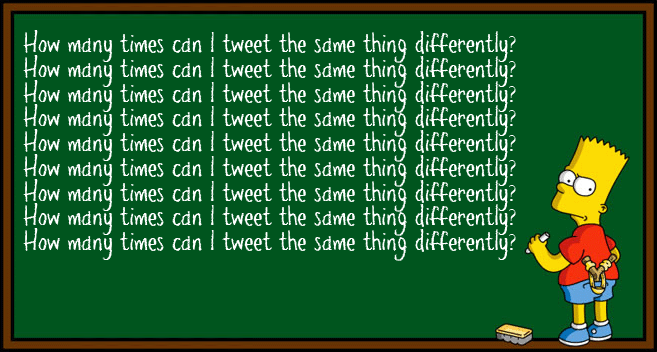You just finished a killer blog post. Reliving the process: first you had to pitch the idea to your editor. Then you reworked the angle to satisfy his feedback. Then it was research time, wherein you bumped up against facts that challenged your hypothesis. Finally, you penned the piece, sweating over decisions as light as commas, as lofty as conclusions.
Now, the post has been published. And you, like a wide-eyed kitten mesmerized by a shiny new object, sit in thrall to the whimsies of the web—watching, waiting, wishing for the big payoff.
Slowly, the clicks come trickling in. But why settle for a trickle when these numbers could be a raging torrent? As soon as your article goes live, it behooves you to SHOUT IT from the rafters. You labored so long and hard on the writing, shouldn’t you reward your efforts with a little promotion?
Indeed you should. In fact, every hack must now be his own flack.
Contrary to custom, a blogger’s job doesn’t end once you click “publish.” Far from it. In this Age of Big Data, where every blog, vlog, and broadcast lives and dies by metrics, your success depends on your page views. And when eyeballs count, Twitter is your best friend. Quicker than placing a phone call, easier than drafting an email, and more trackable than Linking In, tweeting facilitates the Holy Grail of PR: one-on-one outreach en masse.
To wit: Twitter lets you repackage and repurpose your content. This is crucial: you can’t just tweet once, kitten, and expect to snag that ball of string. You must tweet and tweet again, baiting your tweet with various angles and hooks, casting it to segmented audiences.
Equally crucial: instead of publishing your tweets all at once, you need to unloose them over the next few days. (Since the first 24 hours are the most important, it’s best to frontload your tweets for the day of publication, then dribble the rest out over the next day or two.)
This is the playbook I followed for a post I wrote last year for Mashable, which has been shared more than 3,100 times. Here’s how you can achieve similar results for your next piece:
1. Tweet Summaries, Excerpts, and Teasers
Every digital native knows how to tweet the obvious “Check out my new post.” But when the half-life of a tweet is less than three hours, you must keep pushing. Like a politico on the campaign trail, you must say the same thing over and over, drawing on different words for different audiences.
To this end, go beyond the headline and review your text line by line. Identify the juiciest parts, then carve each one into 140 characters of catnip. If your post is meaty, you’ll be able to extract a plethora of summaries, excerpts, and teasers (facts and stats are invariably appetite-whetting). Here are the tweets I crafted to promote my post:
- My new post for @Mashable: How to Optimize Your Headlines for Google and Humans – http://j.mp/JWfPAv
- Done right, a #headline will stop a mouse-moving, page-scrolling, attention-deprived user in his pixels – http://j.mp/JWfPAv
- In addition to writing for eternity, or for one’s mother, today’s writer must also write for Google – http://j.mp/JWfPAv
- With this foundation, you’ll be able to pull off one of the web’s hardest acts: you’ll be able to make Google laugh – http://j.mp/JWfPAv
- New Blog Post: How to Make Google Laugh: SEO Your Headlines – http://j.mp/K9HGOK
- RT @Mashable: How to Optimize Your #Headlines for Google and Humans – http://j.mp/Jes1ZZ #SEO
- Algorithms don’t appreciate wit, irony, humor, or style – http://j.mp/JWfPAv
- The secret of stellar #SEO is that you can have your cake and eat it, too – http://j.mp/JWfPAv
- Why bother with a meta description? – http://j.mp/JWfPAv
- Google, SEO and Writing a Great Headline – http://j.mp/JWfPAv
- How the Mainstream Media Are Optimizing Their Headlines for Google – http://j.mp/JWfPAv
- 3 Ways to Make Your Headlines Catnip for Search Engines – http://j.mp/JWfPAv #SEO
2. Send Shout-Outs (aka Kiss-Ups)
No doubt, you quoted, mentioned, or linked to others in your post. Be sure to recognize them. Play on their vanity—flattery will get you everywhere. Your unspoken goal: get them to share your post with their network. Here are the shout-outs I circulated:
- @DeadlineDiaries Your post, “Google Doesn’t Laugh,” inspired me to write this for @Mashable – http://j.mp/K9HGOK
- @SteveLohr Remember when you wrote, “This Boring Headline Is Written for Google”? At @Mashable, I offer a solution – http://j.mp/JWfPAv
- @yoast Today on @Mashable, I link to and praise your WordPress plug-in for SEO – http://j.mp/JWfPAv
- @SEOmoz @RandFish In a just-published post for Mashable, I quote heavily from your guidance on meta descriptions – http://j.mp/JWfPAv
- @GeneWeingarten Remember “Gene Weingarten Column Mentions Lady Gaga”? In fact, you can have your cake and eat it too – http://j.mp/JWfPAv
3. Give Thanks
If anyone helped you along the way, remember what your mother taught you: thank them. Here are my acknowledgments:
- @PardonMyFrench Thanks for helping me take this from an idea in an email to a 1,000-word post for @Mashable – http://j.mp/JWfPAv
- @lyontef Thanks for helping me take this from an idea in an email to a 1,000-word post for @Mashable – http://j.mp/JWfPAv
- @ChuckDefeo Thanks for helping me take this from an idea in an email to a 1,000-word post for @Mashable – http://j.mp/JWfPAv
4. Push FYIs
Certainly, you can think of people whom your post will interest. Instead of guessing their email address, find their Twitter handle, which is publicly available even if their tweets are private, and tweet them your link.
The caveat: Be careful not to be seen as self-serving. Instead, ask for feedback, or tie your tweet to a subject near and dear to your acquaintance’s heart. Feel free to adapt the headline of your post as needed. Here are the FYI tweets I sent forth:
To the Media
- @JackShafer Some news organizations are optimizing their headlines for Google. Others are not. Curious? – http://j.mp/JWfPAv
- @HowardKurtz This may interest you: How News Outlets Are Optimizing Their Headlines for Both Google and Humans – http://j.mp/JWfPAv
- @poynter @abeaujon @juliemmoos Here’s an easy way that editors of news websites can SEO their headlines – http://j.mp/JWfPAv
- @NiemanLab Which news organizations are optimizing their headlines for Google? The results may surprise you – http://j.mp/JWfPAv
- @zseward If you have a few minutes, I’d love your thoughts on this: How News Outlets Are SEO-ing Their Headlines – http://j.mp/JWfPAv
- @JeremyStahl @KGeee This may interest you: How News Outlets Are Optimizing Their Headlines for Both Google and Humans – http://j.mp/JWfPAv
- @AntDeRosa Any thoughts on this? How News Outlets Are Optimizing Their Headlines for Both Google and Humans – http://on.mash.to/JdigwG
- @nxthompson Over at @Mashable, I offer some ideas on how the @NewYorker can better SEO its headlines – http://j.mp/JWfPAv
- @lheron Over at @Mashable, I offer some ideas on how @WSJ and @NYTimes can better SEO their headlines. Whaddya think? – http://j.mp/JWfPAv
- @pilhofer @sashak @lexinyt Over at @Mashable, I laud the @NYTimes’s SEO strategy – http://j.mp/JWfPAv
- @rajunarisetti Over at @Mashable, I commend the @WSJ’s SEO strategy – http://j.mp/JWfPAv
- @Ckanal The @HuffingtonPost’s SEO program was recently featured on Mashable – http://j.mp/JWfPAv
- @ethanklapper No doubt, you could have written this in your sleep: How News Outlets Are SEO-ing Their Headlines – http://j.mp/JWfPAv
- @JenNedeau I recently knocked @TIME’s SEO strategy—or lack thereof. Any thoughts? – http://j.mp/JWfPAv
To the SEOers
- @JaredBKeller Do your @TheAtlanticWire responsibilities include SEO? If so, here’s some unsolicited advice – http://j.mp/JWfPAv
- @MattCutts I’d love to know what you think of this: How to Optimize Your Headlines for Google and Humans – http://j.mp/JWfPAv
- Hey @SEOSteve Is this Mashable post on SEO accurate? – http://on.mash.to/JdigwG
To the Wordsmiths
- @Plain_Language Where do plain languagers come down on the issue of writing for Google vs. writing for humans? – http://j.mp/JWfPAv
- @JesseSheidlower Are you as troubled as others by the need today to write for Google rather than humans? – http://j.mp/JWfPAv
5. Drop ICYMIs
In your regular use of Twitter, you’ll likely come across people discussing a subject that pertains to your post. If so, chime in and contribute to the conversation.
Of course, make sure the connection is significant. Just because someone links to a post about search engine optimization doesn’t make your post on this subject germane. Relevance requires more than scanning for hash tags. Again, tailor your tweet so that it flows into the dialogue, rather than intrudes on it.
Here are the in-case-you-missed-it opportunities I harnessed:
- @laureni @1bobcohn Here’s the counterargument on why writing to attract Google’s algorithms still matters – http://j.mp/JWfPAv
- @cmoffett Why they should – http://j.mp/JWfPAv
Really?
Of course, the above tweets constitute an aggressive thrust. At this rate, you’re tweeting once every 25 words. Isn’t that excessive? Isn’t this all just a cover for shameless self-promotion?
On one hand, it is. As such, consider warning your followers that over the next day or so, a spammer will be hijacking your Twitter feed, so to speak.
On the other hand, in a digiverse that grows more crowded by the second, you owe it to yourself to wring every tweet, like, plus, pin, Digg, comment, view, and email out of everything you create. Whether you’re a guest contributor or a staff writer, self-promotion is an inescapable part of today’s creative process. The more opportunities you can create and maximize, the more your hard work will receive the recognition it deserves.
Do you agree with this approach? Think it’s nuts? Tweet me your feedback @jrick.
A version of this blog post appeared in PR Daily on February 18, 2013.
Addendum (4/1/2013): It turns out that at this year’s South by Southwest confab, Jonah Peretti expressed the same idea about the disproportionate time we spend writing vs. promoting:
“You need to spend 50% of your time on the idea and 50% on how you spread it. Not 95% and then only a tiny portion on how to spread the idea.”
Addendum (4/16/2013): Peretti again, from the same SXSW presentation:
“When you look at the performance metrics, there was one Mormon for every 10 Jews in 1950, and now there are more Mormons in the world than there are Jews. Mormons know that it’s not enough to practice your religion; you also have to spread your religion.”




